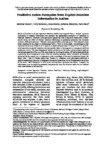Predictive action perception from explicit intention information in autism
| dc.contributor.author | Hudson, M | |
| dc.contributor.author | Nicholson, T | |
| dc.contributor.author | Kharko, A | |
| dc.contributor.author | mckenzie or stancer, rebecca | |
| dc.contributor.author | Bach, P | |
| dc.date.accessioned | 2021-08-20T16:37:30Z | |
| dc.date.issued | 2021-05-23 | |
| dc.identifier.issn | 1069-9384 | |
| dc.identifier.issn | 1531-5320 | |
| dc.identifier.uri | http://hdl.handle.net/10026.1/17626 | |
| dc.description.abstract |
Social difficulties in autism spectrum disorder (ASD) may originate from a reduced top-down modulation of sensory information that prevents the spontaneous attribution of intentions to observed behaviour. However, although people with autism are able to explicitly reason about others' mental states, the effect of abstract intention information on perceptual processes has remained untested. ASD participants (n = 23) and a neurotypical (NT) control group (n = 23) observed a hand either reaching for an object or withdrawing from it. Prior to action onset, the participant either instructed the actor to "Take it" or "Leave it", or heard the actor state "I'll take it" or "I'll leave it", which provided an explicit intention that was equally likely to be congruent or incongruent with the subsequent action. The hand disappeared before completion of the action, and participants reported the last seen position of the tip of the index finger by touching the screen. NT participants exhibited a predictive bias in response to action direction (reaches perceived nearer the object, withdrawals perceived farther away), and in response to prior knowledge of the actor's intentions (nearer the object after "Take it", farther away after "Leave it"). However, ASD participants exhibited a predictive perceptual bias only in response to the explicit intentions, but not in response to the motion of the action itself. Perception in ASD is not immune from top-down modulation. However, the information must be explicitly presented independently from the stimulus itself, and not inferred from cues inherent in the stimulus. | |
| dc.format.extent | 1556-1566 | |
| dc.format.medium | Print-Electronic | |
| dc.language | en | |
| dc.language.iso | en | |
| dc.publisher | Springer Verlag | |
| dc.subject | Autism spectrum disorder | |
| dc.subject | Action prediction | |
| dc.subject | Predictive coding | |
| dc.subject | Implicit | |
| dc.subject | explicit mentalizing | |
| dc.subject | Representational momentum | |
| dc.title | Predictive action perception from explicit intention information in autism | |
| dc.type | journal-article | |
| dc.type | Journal Article | |
| plymouth.author-url | https://www.webofscience.com/api/gateway?GWVersion=2&SrcApp=PARTNER_APP&SrcAuth=LinksAMR&KeyUT=WOS:000653178100003&DestLinkType=FullRecord&DestApp=ALL_WOS&UsrCustomerID=11bb513d99f797142bcfeffcc58ea008 | |
| plymouth.issue | 5 | |
| plymouth.volume | 28 | |
| plymouth.publication-status | Published | |
| plymouth.journal | Psychonomic Bulletin and Review | |
| dc.identifier.doi | 10.3758/s13423-021-01941-w | |
| plymouth.organisational-group | /Plymouth | |
| plymouth.organisational-group | /Plymouth/Faculty of Arts, Humanities and Business | |
| plymouth.organisational-group | /Plymouth/Faculty of Arts, Humanities and Business/Plymouth Institute of Education | |
| plymouth.organisational-group | /Plymouth/Faculty of Health | |
| plymouth.organisational-group | /Plymouth/Faculty of Health/School of Psychology | |
| plymouth.organisational-group | /Plymouth/REF 2021 Researchers by UoA | |
| plymouth.organisational-group | /Plymouth/REF 2021 Researchers by UoA/UoA04 Psychology, Psychiatry and Neuroscience | |
| plymouth.organisational-group | /Plymouth/REF 2021 Researchers by UoA/UoA23 Education | |
| plymouth.organisational-group | /Plymouth/Users by role | |
| plymouth.organisational-group | /Plymouth/Users by role/Academics | |
| dc.publisher.place | United States | |
| dcterms.dateAccepted | 2021-05-01 | |
| dc.rights.embargodate | 2022-5-23 | |
| dc.identifier.eissn | 1531-5320 | |
| dc.rights.embargoperiod | Not known | |
| rioxxterms.versionofrecord | 10.3758/s13423-021-01941-w | |
| rioxxterms.licenseref.uri | http://www.rioxx.net/licenses/all-rights-reserved | |
| rioxxterms.licenseref.startdate | 2021-05-23 | |
| rioxxterms.type | Journal Article/Review |


